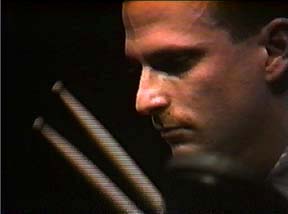
 |
![]()

![]()
JF: If you are a user, I'm not sure how much it is what you want it to be.
JT: Let me ask.
JF: Okay.
JT: I've seen some of the programming you've done for your radio 'grab' performance tool. It was very sophisticated, and obviously took you a while to figure out and code. Do you see the relationship growing between artist and programmer? Do you think it will become increasingly necessary for artists to look to digital tools, and perhaps to even become programmers themselves, so that their tools will reflect exactly what they need?
 JF: For me it's necessary. But there can be great painters that work with nothing but
oil paints. There will be a lot of artists who will work with programmers. But I kind of
fancy myself like Kubrick, that I want to really get down to the nitty-gritty and learn
it myself. He knew all about the lighting and the lighting equipment and the film and
the developing process... and it all became part of his art. I want to do the programming
myself. Already I have discovered things that I would not have discovered if I was on
one end as the artist and someone else was on the other end as a programmer, because
little nuts and bolts things that I, as artist, and programmer, as programmer, would
both agree didn't matter, I found did matter and gave me some really interesting results,
unexpected results in the course of programming this interface. Any artist that says oh,
it's necessary, is being silly because as I said you always can do without. But it will
be a part of natural artistic evolution, I think. There will also be a difference in the
work of those, like me, who do their own programming, those who work with programmers,
and those who just sit there with Photoshop.
JF: For me it's necessary. But there can be great painters that work with nothing but
oil paints. There will be a lot of artists who will work with programmers. But I kind of
fancy myself like Kubrick, that I want to really get down to the nitty-gritty and learn
it myself. He knew all about the lighting and the lighting equipment and the film and
the developing process... and it all became part of his art. I want to do the programming
myself. Already I have discovered things that I would not have discovered if I was on
one end as the artist and someone else was on the other end as a programmer, because
little nuts and bolts things that I, as artist, and programmer, as programmer, would
both agree didn't matter, I found did matter and gave me some really interesting results,
unexpected results in the course of programming this interface. Any artist that says oh,
it's necessary, is being silly because as I said you always can do without. But it will
be a part of natural artistic evolution, I think. There will also be a difference in the
work of those, like me, who do their own programming, those who work with programmers,
and those who just sit there with Photoshop.
But just because I am customizing my digital audio processing doesn't mean that we've exhausted the possibilities with a MIDI sequencer. We haven't. I would say we maybe haven't even come close to that, really understanding what MIDI sequencing is about. I know it's old hat, because now we're all about digital audio. But that I think is one of the misconceptions about technology, that as fast as it evolves we digest it. We don't. I think that there are some fundamental truths about just the nature of recorded sound which have been around for the whole century that have really only come to light in the last maybe fifteen - twenty years. We had recorded sound and we had repetition. We had tape loops in the fifties, they were popularized in the late sixties. But I think all of this wasn't really fully understood until later. So you've got to be kidding if you think the MIDI revolution is old hat and leaves nothing more to be discovered within it.
JT: So the technology is deep. You're saying that it's not just a surface thing, that we get to this point and then we do the next thing and the next thing. There is all of this piling up that accumulates as we are making these leaps.
JF: Yes. It takes some time to really get depth with our use of this. Just because I've jumped ahead and started programming my own work... I decided not to buy store-bought processing and looping boxes, people that do may do great stuff, stuff that's very insightful. A person that just sits there with Photoshop may come up with work that expresses greater insights about digital technology and the visual than the person that is customizing their own 3-D imaging programming.

Copyright © 13 February 2000 Jeff Talman, Saratoga Springs, NY, USA
![]()